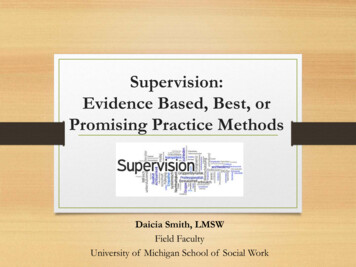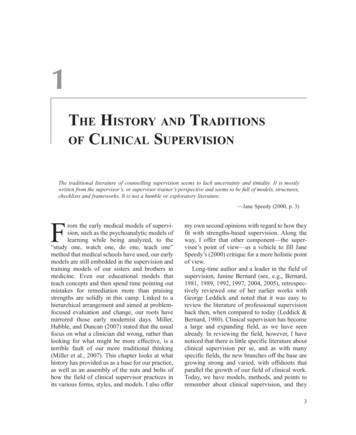
Transcription
Supervision:Evidence Based, Best, orPromising Practice MethodsDaicia Smith, LMSWField FacultyUniversity of Michigan School of Social Work
What is it?At your tables, take 3 minutes to come upwith one word to describe supervision.2
During Our Time Together: Identify best and promising practice methods forsupervision Recognize four supervision models3
TraditionalMission of Supervision Acquisition of knowledge to the application of knowledge in thefield. Opportunity to apply knowledge and skills obtained duringtraining to actual practice situations. Clinicians continue to gain insight and review cases and drawfrom others experiences4
5
A Working Definition*ofSupervision“A formal process of professional supportand learning which enables practitioners todevelop knowledge and competence,assume responsibility for their own practiceand enhance consumer protection and safetyin complex situations.”England Department of Health, 1993*Applicable to all stages of practice6
Solve this equationE R S2 ?IFE Theory and KnowledgeR Your AgencyS YOU7
Solve this equationExpectations Reality Supervison2 8
ANSWERProfessional University of MichiganSchool of Social Work Graduate9
Why are we having aDiscussion about this?10
Why are we having aDiscussion about this?1. Supervisors in health and human servicefields are working with or for vulnerablepopulations that increases the need to becompetent in their current positions.11
Why are we having aDiscussion about this?2. We recognize that supervisors areaccepting an ADDITIONAL roleand are having increased challengesin finding the time to support theirstaff, train and educate students andsupervise volunteers.12
Why are we having aDiscussion about this?3. Supervision has been recognized as a distinctarea of practice.(Fouad et al.,2009)13
SUPERVISION VSMANAGEMENT Supervision focused on development puts the supervisor in the role of ateacher, mentor, and coach. The supervisor has a goal to provideprofessional and personal development to increase their competencies intheir current and/or future roles. In the social work field, developmentshould include opportunities for reflection. The person being supervisedshould feel supported and valued. Management includes administration of tasks and logistics of theemployee/volunteer/intern responsibilities and role.Utilized together, a supervisor can promote optimal performance.14
How Do We Know What Is Best? Peake, et al (2002) demonstrates that less than 20% of clinicalsupervisors had formal training in the supervisory process “There has been widespread concern that the reflectivecomponent of supervision has been dwindling under theimpact of managerialism and there have been calls for it to bereinstated.”15
What is Best?ALTHOUGH WE LIKE TO USE RESEARCH TO INFORM PRACTICE . Supervision has yet be conceptualized in studies adequatelyEllis, Ladany, Krengel, and Schult (1996) reviewed the clinicalsupervision literature and found that approximately 80% of 144studies were poorly conceptualized (e.g., implicit theorizing,inconsequential or ambiguous hypotheses, and conceptual andmethodological flaws).16
Current Work Being Done Association for Counselor Education andSupervision (ACES) National Association of Social Workers (NASW) Minnesota Association for Infant and EarlyChildhood Mental Health17
4 Types of Supervision RENT EFFORTS TO ENSURE THAT ALL SUPERVISION ISUTILIZING A TRAUMA INFORMED LENS18
Administrative Supervisor: Clinical Supervisor: Developmental Supervisor: Reflective Supervisor:19
4 Types of Supervision Administration Includes oversight of tasks and logistics. Monitors compliance and adherence topolicies and procedures20
4 Types of Supervision Clinical: Case Based Review of strategies utilized andalternative solutions21
4 Types of Supervision Developmental: Supervisor is in the role of a teacher,mentor, and coach Competency based22
4 Types of Supervision Reflective Converts tacit experience into knowledge Reviews thoughts, feelings, and behaviorsassociated with practice23
Administrative Supervision WHAT WE DO BEST Tasks Management Logistics Planning24
Administrative Supervision WHAT WE FORGET WHEN WORKING WITHSTUDENTS: Ethical Dilemmas Managing Roles Logistics that have become second nature Managing Case Files Attire Vacation/Sick Procedures25
SupervisionGeneral vs. Clinical Taking some direction from education: General Supervision Focuses on: Overall improvement ofthe setting and customer Clinical Supervision Focuses on: Overall development ofthe employeeAbiddin, N. Z. 2008. Exploring clinical supervision to facilitate the creative process of supervision. TheJournal of International Social Research. (1)3: 14–31.26
Manchester Clinical Supervision Scale The MCSS[c], was utilized in one of largest Clinical Supervisionstudies has helped to establish some public guidelines about theoptimum conditions required for conducting the most effectivesupervision sessions. Winstanley, J., & White, E. (2003). Six subscales (formerly seven) Three Domains Normative: focus on standards and audits Restorative: focus on development and welfare ofsupervisee Formative: focus on knowledge and skilldevelopment27
EVIDENCEEvidence* recommends that: Longer sessions are better (60 minutes)More frequent sessions are better (at least monthly)Sessions in groups may be more effectiveSessions away from the workplace may be betterSupervisor trust/rapport is higher if the Supervisor ischosen.* findings based on data gathered from 1,027 respondents in eight centers located in England and Scotland28
DEVELOPMENTAL MODELSOF SUPERVISION Supervisors identify the supervisee’s current stage and providefeedback and support that is appropriate to that stage, whilefacilitating their movement to the next stage. Development of a professional relationship between supervisorand supervisee supports the growth of advanced criticalthinking skills. 3 levels of development Levels are NOT linear29
Characteristics of SuperviseesEntry level ProfessionalsHigh motivationHigh in anxietyFearful of EvaluationMid levelFluctuating confidence andmotivationOften linking personal moodto success with clientsEssentially SecureStable in motivationAccurate empathyUse therapeutic self ininterventionNovice to Expert30(Falender & Shafranske, 2004)
Supervisor ApproachesDIRECTIVECOLLABORATIVE Modeling Directing Measuring Presenting Interacting CounteractingNondirective Listening Encouraging ClarifyingNovice to Expert31(Falender & Shafranske, 2004)
Reflective Supervision Incorporates the practice of reflecting onpractitioners interactions Mirroring Interactions Impacts32
Reflective 2012 study by Matsuo that examined nursing managers revealedthat reflective practice is closely associated with goal setting androle modeling. The results indicated that managers promote reflective practiceof staff by clarifying the mission of the setting and promotingrole modeling. This suggests that goal setting (Latham andLocke, 2007; Locke and Latham, 2002) and social learning(Bandura, 1977, 1986) are antecedents of reflective practice.33
Reflective Supervision Clinician’s relationship with client often replicated inthe supervisory relationship and vice versa. Relational processes that are present support andbuild a clinicians ability to be effective in thetherapeutic change process. Potential to provide clinicians with the opportunityto have a similar experience to clients where they arepushed to be authentic (Gilkerson, 2004; heffron,2005)34
Students are Great Imitators So Give ThemSomething Great to Imitate35
Trauma- Informed Supervision GuidelinesShould be added to all types of supervision Acknowledges culture of individual and organizationRespect, honesty, kindness, and fairnessAccentuate the positivesBe calm and assist in calmingAsk questionsUtilize empowerment approachPromote self care36
Administrative Supervisor: Clinical Supervisor: Developmental Supervisor: Reflective Supervisor:37
Evaluate YourselfBEST PRACTICE STRATEGIES UTILIZED: Supervision sessions approximately 60 minutes Supervision sessions held at least monthly (weekly for students) Supervision sessions held in a group format Time is taken to develop trust and rapport with supervisor/facilitator38
ImplementationWhat are the Challenges and Treasures?Share with your neighbor:1. One thing that makes it challenging to engage in supervision.2. One thing you do really well as a supervisor.3. One thing you can commit to do this term with your supervisee.39
What Would You Do?A 24 year old 16 month Interpersonal Practice Mental Health MSW student with a minor inCommunity Organizing is placed at your agency. The student identifies as an African American femaleand utilizes the pronouns she/her/hers. She entered graduate school immediately following completionof her undergraduate degree in psychology. Her first task was to review the organizations policy andprocedure manual and provide an outline of important facts. You reach out to her after 1 week and askhow things are going and she reports “fine”. The next week, you ask to see the outline and she reportsthat it is not complete. After further questioning, she shares that she did not have a template of whatwas expected and she was waiting for you to schedule supervision in order to ask that question.The student later contacts OFI and shares that her supervisor is not supporting her and that she thinksthis is not a good placement for her. She goes on to share that the field instructor “ignores” her andhas only been at the office twice since she began and they keep her in a room to “read a large book”.She is clear that this is not what she expects from the “#1 School of Social Work in the country.”What stage of learning is this student in?What are activities that the field instructor can do to support the student?How should the field liaison respond?40
41
REFERENCESAdamowich, T., Kumsa, M. K., Rego, C., Stoddart, J., & Vito, R. (2014). Playing hideand seek: Searching for the use of self in social work practice. Reflective Practice (15)2,131-143.Association of Social Work Boards. (2011). Model Social Work Practice Act. Culpepper,VA: Author. Retrieved from www.aswb.org/pdfs/Model law.pdfFalender, C. A., & Shafranske, E. P. (2004). Clinical supervision: A competency-basedapproach. Washington, DC: American Psychological AssociationKadushin, A., Harkness, D. (2014). Supervision in Social Work, 5e. 5., fifth edition. NewYork, NY: Columbia University Press.O'Rourke, P. (2011), The significance of reflective supervision for infant mental healthwork. Infant Ment. Health J., 32: 165–173. doi:10.1002/imhj.20290Tomlin, A., Weatherston, D., & Pavkov, T. (2014). Critical components of reflectivesupervision: Responses from expert supervisors in the field. Infant Mental Health Journal,35(1), 70–80. doi:10.1002/imhj.2014.35.issue-142
2012 study by Matsuo that examined nursing managers revealed that reflective practice is closely associated with goal setting and role modeling. The results indicated that managers promote reflective practice of staff by clarifying the mission of the setting and promoting role modeling. This suggests that . goal setting (Latham and











